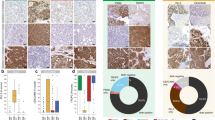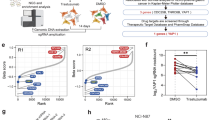Abstract
Background
The steroid receptor RNA activator protein (SRAP) is a newly described protein modulating the activity of multiple transcription factors including the estrogen receptor (ER). We have recently reported the immunodetection by Western blot of multiple SRAP peptides in breast tissue. High expression of these peptides, assessed by tissue micro-array (TMA) analysis, was associated with poor prognosis in patients whose primary tumors were ER positive (ER+). In such studies, it is recognized that intensity as well as specificity of the signal detected directly depends upon the antibody used as well as the position of the epitope recognized. To confirm the potential relevance of SRAP as a new prognostic factor, it is critical to establish whether similar results are obtained with independent antibodies.
Methods
Two commercial anti-SRAP antibodies (742A and 743A), respectively, recognizing the N- and C-terminal extremity of the protein, were first used to analyze by Western blot SRAP expression in protein extracts from frozen breast tumor tissue sections. These antibodies were further used to investigate by immunohistochemistry (IHC) SRAP location in paraffin-embedded breast tumors. Comparative TMA analysis of 170 ER+ tumors was eventually performed in order to establish the potential associations existing between SRAP expression and clinical outcome.
Results
Multiple SRAP peptides were differentially detected by Western blot. Both antibodies led to similar nuclear and cytoplasmic staining in breast tissue section. A solid correlation was found (Spearman r = 0.46, P < 0.001) between 742A and 743A IHC scores. Results from both antibodies independently showed that dividing expression levels into lower 25 percentile, 26–75 percentile, and highest 25 percentile demonstrated a hazard ratio (HR) of 1.82 (P = 0.0042) for 742A antibody and 1.35 (P = 0.14) for 743A antibody. When both scores are combined, double high expressor (by 742A and 743A) was associated with a poor prognosis of breast-cancer-specific survival (Mantel–Cox: P = 0.005, HR = 2.24).
Conclusion
Overall, our data suggest the existence in breast tumor tissue of multiple SRAP-like peptides. Assessing their expression in primary breast tumors can predict clinical outcome in ER+ breast cancer patients.





Similar content being viewed by others
References
Abd El-Rehim DM, Ball G, Pinder SE, Rakha E, Paish C, Robertson JFR et al (2005) High-throughput protein expression analysis using tissue microarray technology of a large well-characterised series identifies biologically distinct classes of breast cancer confirming recent cDNA expression analyses. Int J Cancer 116(3):340–350
American Cancer Society (2010) http://www.cancer.org/docroot/STT/STT_0.asp. Breast Cancer Facts & Figures 2009–2010
Borth N, Massier J, Franke C, Sachse K, Saluz HP, Hanel F (2010) Chlamydial protease CT441 interacts with SRAP1 co-activator of estrogen receptor alpha and partially alleviates its co-activation activity. J Steroid Biochem Mol Biol 119(1–2):89–95
Cheang MCU, Chia SK, Voduc D, Gao DX, Leung S, Snider J et al (2009) Ki67 Index, HER2 status, and prognosis of patients with luminal B breast cancer. J Natl Cancer Inst 101(10):736–750
Chooniedass-Kothari S, Hamedani MK, Auge C, Wang X, Carascossa S, Yan Y et al (2010) The steroid receptor RNA activator protein is recruited to promoter regions and acts as a transcriptional repressor. FEBS Lett 584(11):2218–2224
Chooniedass-Kothari S, Emberley E, Hamedani MK, Troup S, Wang X, Czosnek A et al (2004) The steroid receptor RNA activator is the first functional RNA encoding a protein. FEBS Lett 566(1–3):43–47
Chooniedass-Kothari S, Hamedani MK, Troup S, Hube F, Leygue E (2006) The steroid receptor RNA activator protein is expressed in breast tumor tissues. Int J Cancer 118(4):1054–1059
Chooniedass-Kothari S, Vincett D, Yan Y, Cooper C, Hamedani MK, Myal Y et al (2010) The protein encoded by the functional steroid receptor RNA activator is a new modulator of ER alpha transcriptional activity. FEBS Lett 584(6):1174–1180
Colley SM, Leedman PJ (2011) Steroid receptor RNA activator—A nuclear receptor coregulator with multiple partners: insights and challenges. Biochimie 93(11):1966–1972
Cooper C, Guo JM, Yan Y, Chooniedass-Kothari S, Hube F, Hamedani MK et al (2009) Increasing the relative expression of endogenous non-coding steroid receptor RNA activator (SRA) in human breast cancer cells using modified oligonucleotides. Nucleic Acids Res 37(13):4518–4531
Cooper C, Vincett D, Yan Y, Hamedani MK, Myal Y, Leygue E (2011) Steroid receptor RNA activator bifaceted genetic system: heads or tails? Biochimie 93(11):1973–1980
Foulds CE, Tsimelzon A, Long W, Le A, Tsai SY, Tsai MJ et al (2010) Research resource: expression profiling reveals unexpected targets and functions of the human steroid receptor RNA activator (SRA) gene. Mol Endocrinol 24(5):1090–1105
Hu ZY, Fan C, Oh DS, Marron JS, He XP, Qaqish BF et al (2006) The molecular portraits of breast tumors are conserved across microarray platforms. BMC Genomics 7:96
Hube F, Guo JM, Chooniedass-Kothari S, Cooper C, Hamedani MK, Dibrov AA et al (2006) Alternative splicing of the first intron of the steroid receptor RNA activator (SRA) participates in the generation of coding and noncoding RNA isoforms in breast cancer cell lines. DNA Cell Biol 25(7):418–428
Kurisu T, Tanaka T, Ishii J, Matsumura K, Sugimura K, Nakatani T et al (2006) Expression and function of human steroid receptor RNA activator in prostate cancer cells: role of endogenous hSRA protein in androgen receptor-mediated transcription. Prostate Cancer Prostatic Dis 9(2):173–178
Leygue E (2007) Steroid receptor RNA activator (SRA1): unusual bifaceted gene products with suspected relevance to breast cancer. Nucl Recept Signal 5:1–13
Perou CM (2002) Molecular classification of human breast carcinomas using patterns of gene expression. Eur J Cancer 38:S125
Perou CM, Sorlie T, Eisen MB, van de Rijn M, Jeffrey SS, Rees CA et al (2000) Molecular portraits of human breast tumours. Nature 406(6797):747–752
Pohlmann PR, Mayer IA, Mernaugh R (2009) Resistance to trastuzumab in breast cancer. Clin Cancer Res 15(24):7479–7491
Ring A, Dowsett M (2004) Mechanisms of tamoxifen resistance. Endocr Relat Cancer 11(4):643–658
Ross JS, Fletcher JA, Linette GP, Stec J, Clark E, Ayers M et al (2003) The HER-2/neu gene and protein in breast cancer 2003: biomarker and target of therapy. Oncologist 8(4):307–325
Skliris GP, Leygue E, Curtis-Snell L, Watson PH, Murphy LC (2006) Expression of oestrogen receptor-beta in oestrogen receptor-alpha negative human breast tumours. Br J Cancer 95(5):616–626
Sorlie T, Perou CM, Tibshirani R, Aas T, Geisler S, Johnsen H et al (2001) Gene expression patterns of breast carcinomas distinguish tumor subclasses with clinical implications. Proc Natl Acad Sci USA 98(19):10869–10874
Sorlie T, Tibshirani R, Parker J, Hastie T, Marron JS, Nobel A et al (2003) Repeated observation of breast tumor subtypes in independent gene expression data sets. Proc Natl Acad Sci USA 100(14):8418–8423
Vicent GP, Nacht AS, Zaurin R, Font-Mateu J, Soronellas D, Le DF et al (2013) Unliganded progesterone receptor-mediated targeting of an RNA-containing repressive complex silences a subset of hormone-inducible genes. Genes Dev 27(10):1179–1197
Yan Y, Cooper C, Skliris GP, Penner C, Cooper C, Murphy LC et al (2009) Steroid receptor RNA activator protein (SRAP): a potential new prognostic marker for estrogen receptor-positive/node-negative/younger breast cancer patients. Breast Cancer Res 11(5):R67
Yan Y, Li X, Blanchard A, Bramwell VH, Pritchard KI, Tu D et al (2013) Expression of both estrogen receptor-beta 1 (ER-β1) and its co-regulator steroid receptor RNA activator protein (SRAP) are predictive for benefit from tamoxifen therapy in patients with estrogen receptor-alpha (ER-α)-negative early breast cancer (EBC). Ann Oncol 24(8):1986–1993
Acknowledgments
This work was supported by grants from the Canadian Institute of Health Research (CIHR), the CancerCare Manitoba Foundation (CCMF), the Manitoba Health Research Council (MHRC), and the Canadian Breast Cancer Foundation (CBCF). Y.Y. received a CIHR Graduate Studentship Award.
Conflict of interest
No competing interests to be declared.
Author information
Authors and Affiliations
Corresponding author
Electronic supplementary material
Below is the link to the electronic supplementary material.
432_2013_1485_MOESM1_ESM.eps
Supplementary material Fig. 1 Nuclear and cytoplasmic extracts from MCF7 cells were prepared as described in Materials and Methods and analyzed by Western blot using 742A and 743A (anti-SRAP) antibodies, anti-GAPDH antibody (cytoplasmic protein marker) and SP3 antibody (nuclear protein marker). A 30-Kd SRAP peptide was detected in both nuclear and cytoplasmic fraction. (EPS 1247 kb)
Rights and permissions
About this article
Cite this article
Yan, Y., Penner, C.C., Skliris, G.P. et al. Steroid receptor RNA activator protein (SRAP) expression as a prognostic factor in ER+ human breast tumors. J Cancer Res Clin Oncol 139, 1637–1647 (2013). https://doi.org/10.1007/s00432-013-1485-2
Received:
Accepted:
Published:
Issue Date:
DOI: https://doi.org/10.1007/s00432-013-1485-2




